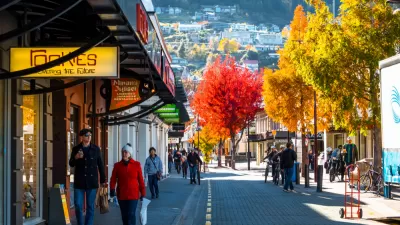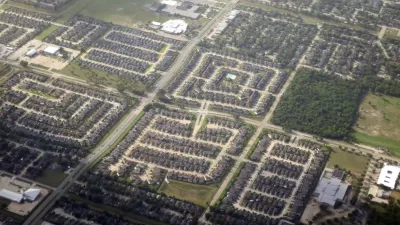Density -- either high or low or somewhere in the middle -- is a key defining element of our cities. In this essay, Witold Rybczynski looks at the relative densities of U.S. cities and suggests that things may start to change subtly.
"There are a number of ways in which American cities could become denser. In vertical downtowns, tall buildings could simply get taller, or older office towers could be converted to residential use, as has happened in some business districts. The most common form of urban densification is the conversion of disused waterfronts, decommissioned Navy yards, and obsolete industrial areas into housing and office developments, an attractive strategy since it does not displace existing residents. In older city neighborhoods, taller structures could progressively replace three- or four-story row houses and low apartment buildings, though community resistance makes this a slow process.
Suburban densification is more challenging. In Philadelphia, where I live, it was common practice in the mid-20th century to subdivide large suburban estates into communities of single-family houses, but such open spaces in the suburbs are increasingly rare. Neighborhoods of single-family housing can be made denser by building clusters of smaller houses on what were previously large single-house lots, or by introducing row houses or low-rise apartment buildings. Both strategies involve radical changes to neighborhood identity, however. Perhaps the greatest challenge will be to increase density in the large planned-unit communities that have proliferated in the past few decades. In these, any change is constrained by homeowner associations in which even a small minority of members can effectively block alterations they find objectionable."
In this discussion of density and cities, Rybczynski wonders if spread-out urbanity will continue, if urban density will take hold, or if it will be a combination of the two.
FULL STORY: Dense, Denser, Densest

Manufactured Crisis: Losing the Nation’s Largest Source of Unsubsidized Affordable Housing
Manufactured housing communities have long been an affordable housing option for millions of people living in the U.S., but that affordability is disappearing rapidly. How did we get here?

Americans May Be Stuck — But Why?
Americans are moving a lot less than they once did, and that is a problem. While Yoni Applebaum, in his highly-publicized article Stuck, gets the reasons badly wrong, it's still important to ask: why are we moving so much less than before?

Using Old Oil and Gas Wells for Green Energy Storage
Penn State researchers have found that repurposing abandoned oil and gas wells for geothermal-assisted compressed-air energy storage can boost efficiency, reduce environmental risks, and support clean energy and job transitions.

Greening Oakland’s School Grounds
With help from community partners like the Trust for Public Land, Oakland Unified School District is turning barren, asphalt-covered schoolyards into vibrant, green spaces that support outdoor learning, play, and student well-being.

California Governor Suspends CEQA Reviews for Utilities in Fire Areas
Utility restoration efforts in areas affected by the January wildfires in Los Angeles will be exempt from environmental regulations to speed up the rebuilding of essential infrastructure.

Native American Communities Prepare to Lead on Environmental Stewardship
In the face of federal threats to public lands and conservation efforts, indigenous groups continue to model nature-centered conservation efforts.
Urban Design for Planners 1: Software Tools
This six-course series explores essential urban design concepts using open source software and equips planners with the tools they need to participate fully in the urban design process.
Planning for Universal Design
Learn the tools for implementing Universal Design in planning regulations.
Heyer Gruel & Associates PA
City of Moreno Valley
Institute for Housing and Urban Development Studies (IHS)
City of Grandview
Harvard GSD Executive Education
Salt Lake City
NYU Wagner Graduate School of Public Service
City of Cambridge, Maryland





























